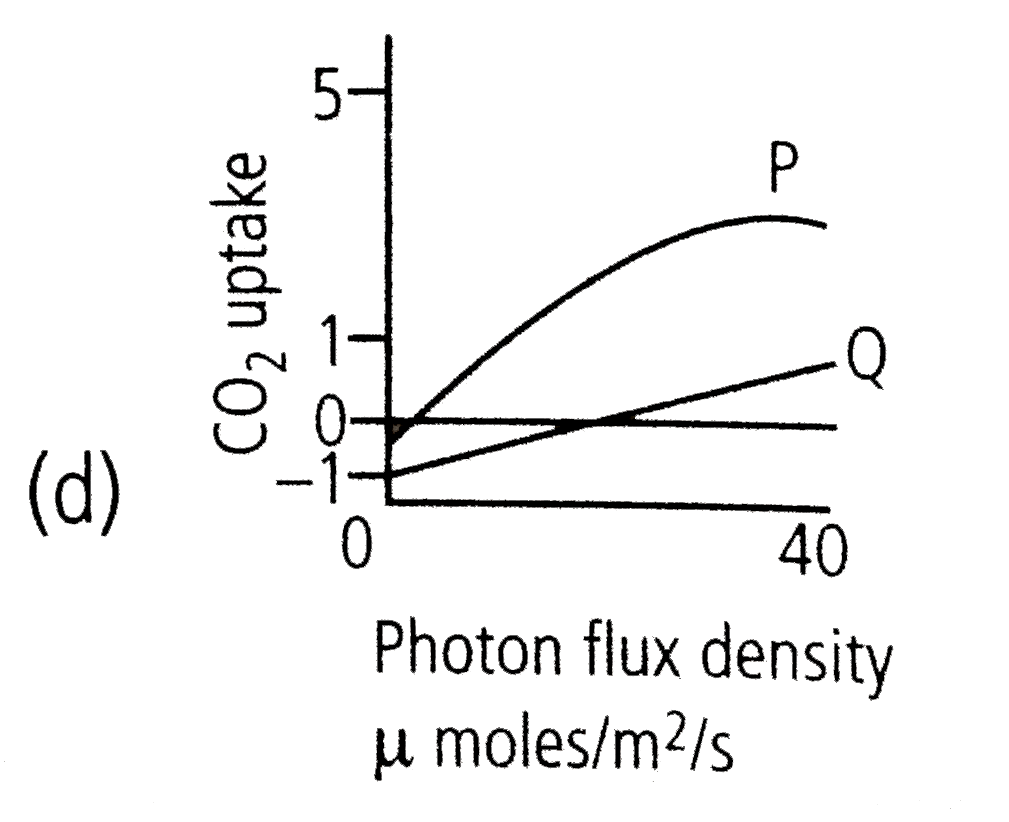Which of the following graphs correctly depicts the rate of photosynthesis of sun plant (P) and shade plant (Q)?




The correct Answer is:D
To determine which graph correctly depicts the rate of photosynthesis for sun plants (P) and shade plants (Q), we need to understand how these two types of plants respond to varying light intensities.
1. Understanding Sun Plants and Shade Plants:
- Sun plants (P) are adapted to high light intensities and can achieve high rates of photosynthesis when exposed to strong sunlight.
- Shade plants (Q), on the other hand, thrive in low light conditions and are more efficient at lower light intensities. They cannot achieve high photosynthetic rates under intense light.
2. Graph Characteristics:
- The x-axis of the graph typically represents light intensity (photon flux density), while the y-axis represents the rate of photosynthesis (carbon dioxide uptake).
- For sun plants, the graph should show a steep increase in the rate of photosynthesis with increasing light intensity, eventually reaching a plateau as it saturates.
- For shade plants, the graph should show a more gradual increase in the rate of photosynthesis with light intensity, and it will not reach the same high rates as sun plants, even at high light intensities.
3. Analyzing the Given Graphs:
- Graph A: Shows both plants rising rapidly and reaching high rates at high light intensity, which is incorrect for shade plants.
- Graph B: Shows a plateau for sun plants at low light intensity, which is also incorrect because sun plants should rise steeply at high light intensity.
- Graph C: Similar issues as Graph A, with both plants showing high rates at high light intensity.
- Graph D: Shows sun plants rising steeply with increasing light intensity and shade plants rising more gradually, which is consistent with their respective adaptations.
4. Conclusion:
- Based on the analysis, Graph D correctly depicts the rate of photosynthesis for sun plants (P) and shade plants (Q). Sun plants show a steep increase in photosynthesis with light intensity, while shade plants show a slower increase.
Final Answer:
The correct graph is D.
- Sun plants (P) are adapted to high light intensities and can achieve high rates of photosynthesis when exposed to strong sunlight.
- Shade plants (Q), on the other hand, thrive in low light conditions and are more efficient at lower light intensities. They cannot achieve high photosynthetic rates under intense light.
- The x-axis of the graph typically represents light intensity (photon flux density), while the y-axis represents the rate of photosynthesis (carbon dioxide uptake).
- For sun plants, the graph should show a steep increase in the rate of photosynthesis with increasing light intensity, eventually reaching a plateau as it saturates.
- For shade plants, the graph should show a more gradual increase in the rate of photosynthesis with light intensity, and it will not reach the same high rates as sun plants, even at high light intensities.
- Graph A: Shows both plants rising rapidly and reaching high rates at high light intensity, which is incorrect for shade plants.
- Graph B: Shows a plateau for sun plants at low light intensity, which is also incorrect because sun plants should rise steeply at high light intensity.
- Graph C: Similar issues as Graph A, with both plants showing high rates at high light intensity.
- Graph D: Shows sun plants rising steeply with increasing light intensity and shade plants rising more gradually, which is consistent with their respective adaptations.
- Based on the analysis, Graph D correctly depicts the rate of photosynthesis for sun plants (P) and shade plants (Q). Sun plants show a steep increase in photosynthesis with light intensity, while shade plants show a slower increase.
The correct graph is D.
Topper's Solved these Questions
- PHOTOSYNTHESIS IN HIGHER PLANTSBook:NCERT FINGERTPS ENGLISHChapter:PHOTOSYNTHESIS IN HIGHER PLANTSExercise:Photosynthesis In Higher Plants
Explore 136 Videos
- NEURAL CONTROL AND COORDINATIONBook:NCERT FINGERTPS ENGLISHChapter:NEURAL CONTROL AND COORDINATIONExercise:All Questions
Explore 144 Videos
- PLANT GROWTH AND DEVELOPMENTBook:NCERT FINGERTPS ENGLISHChapter:PLANT GROWTH AND DEVELOPMENTExercise:Plant Growth And Development
Explore 154 Videos
Similar Questions
Knowledge Check
Which of the following correctly depicts the biochemical reaction of photosynthesis?
AC6H12O6+6O2Enzymes−−−−→6CO2+6H2O+energyBC6H12O6+6O2+6H2O→6CO2+12H2O+ energyC6CO2+6H2OSunlight−−−−−−→ChlorophyllC6H12O6+6O2D6CO2+12H2OSunlight−−−−−−→ChlorophyllC6H12O6+6O2+6H2OWhich of the following correctly depicts the dental formula of a child?
A21122112B21022102C21232123D21112111Which of the following orders correctly depicts the decreasing order of stability of carbanion?
A BOHC−¯¯¯C∣CHO−CHO>OHC−¯¯¯CH−CHO>H3C−C∣∣O−¯¯¯CH−C∣∣O−CH3>¯¯¯CH3−CHOC¯¯¯CH2NO2<¯¯¯CH2CN<¯¯¯CH2Cl<¯¯¯CH2CH3D
BOHC−¯¯¯C∣CHO−CHO>OHC−¯¯¯CH−CHO>H3C−C∣∣O−¯¯¯CH−C∣∣O−CH3>¯¯¯CH3−CHOC¯¯¯CH2NO2<¯¯¯CH2CN<¯¯¯CH2Cl<¯¯¯CH2CH3D
Which of the following is not a plant factor regulating the photosynthesis ?
View SolutionWhich of the following correctly depicts the aestivation of petals in the flower of cotton ?
View SolutionWhich one of the following is limiting rate of photosynthesis in nature
View SolutionWhich of the following correctly characterizes the plant body of Funaria?
View SolutionChoose the diagram which correctly depicts anaphase I
View Solution

